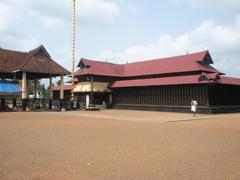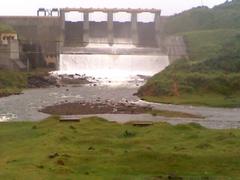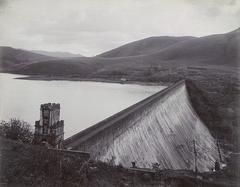Thazhathangady Juma Masjid Visiting Hours, Tickets, and Visitor Guide
Date: 04/07/2025
Introduction
Thazhathangady Juma Masjid, perched on the tranquil banks of the Meenachil River in Kottayam, Kerala, is among India’s oldest mosques and a profound symbol of Kerala’s syncretic culture. With a legacy spanning over 1,300 years, this mosque embodies the harmonious blending of Kerala’s indigenous wooden architecture and Islamic artistic sensibilities, serving as both a place of worship and a vibrant cultural landmark. This guide provides a comprehensive overview, including historical context, key architectural features, visiting information, accessibility, and recommendations for a memorable visit to this exceptional heritage site (Heritage.in; Incredible India; TravelTriangle).
Historical Overview and Cultural Significance
Origins and Early History
Thazhathangady Juma Masjid is reputed to be over 1,300 years old, its foundation linked to the arrival of Islam in Kerala through Malik Dinar in the 7th century CE. Local tradition credits his son, Habib Dinar, with establishing this mosque in the 8th century, marking Thazhathangady as a historic epicenter of trade and interfaith exchange (Heritage.in; Incredible India).
Patronage and Community Role
The mosque flourished under the patronage of the Thekkumkoor kings who encouraged religious diversity and actively supported the construction of places of worship for various communities, including Muslims, Christians, and Brahmins. Their support extended to land and timber grants, fostering the development of Thazhathangady as a multicultural hub (Radiance News).
Symbol of Pluralism and Interfaith Harmony
Remarkably situated beside an ancient church and temple, the mosque stands as a living testament to Kerala’s tradition of religious tolerance and communal coexistence, having played roles in both daily community life and pivotal historical events such as India’s freedom movement.
Architectural Highlights
Unique Kerala-Islamic Style
Thazhathangady Juma Masjid showcases a rare two-storied wooden structure spanning approximately 4,200 square feet. Its architecture elegantly combines regional temple designs with Islamic elements, notably:
- Sloping Tiled Roofs and Carved Pillars: The mosque eschews the domes and minarets typical of Islamic architecture in favor of sloping tiled roofs, intricately carved wooden pillars, and colorful gables (Incredible India).
- Mukkutty Saaksha (Triple-Latch Lock): The doors feature a unique three-step wooden locking system, an ingenious example of traditional Kerala craftsmanship.
- Sundial (Nizhal Khadikaram): An ancient sundial still used to determine prayer times stands in the courtyard (New Indian Express).
- Stone Water Tank: The ablution tank, carved from a single stone block, is historically used for ritual cleansing and showcases environmental adaptation and resourcefulness.
Interior Layout and Ornamentation
- Prayer Halls: The mosque features two main prayer halls—the Puram Palli (outer) and Akam Palli (inner)—supported by massive wooden pillars constructed without nails (Onmanorama).
- Intricate Carvings: Walls and ceilings are adorned with elaborate woodwork, floral motifs, geometric patterns, and Quranic inscriptions.
- Secret Chamber: Hidden passages and double walls, designed for community defense and safeguarding valuables, reflect the mosque’s historical importance in trade and security.
Renovation and Preservation
In 2012, the southern part of the mosque was renovated using modern materials alongside traditional methods, ensuring the preservation of its unique character while accommodating growing community needs (Wanderboat).
Visiting Hours, Entry Policies, and Practical Information
Visiting Hours
- General visiting hours: 8:00 AM to 6:00 PM daily, with variations during religious festivals.
- Some sources note public visiting slots as 8:00 AM–12:00 PM and 3:30 PM–4:30 PM (TravelTriangle).
- The mosque is open for worshippers outside these hours; confirm with mosque authorities for the latest timings.
Entry and Ticket Information
- Entry is free; no tickets are required (Indian Panorama).
- Non-Muslim visitors are welcome except during Ramadan and major festivals, when entry is restricted to maintain sanctity.
Dress Code and Conduct
- Modest attire is mandatory: men should wear long trousers and sleeved shirts; women (on permitted days) must cover arms, legs, and hair (Indian Panorama).
- Footwear must be removed before entering prayer areas.
- Maintain silence, avoid touching religious objects unless invited, and follow staff guidance.
Gender-Specific Access
- Traditionally, only men could enter the main prayer hall. Since 2019, Muslim women are allowed inside on April 24 and May 8 with proper attire (Wikipedia).
- Non-Muslim women and women on other days may view the exterior and public areas but cannot enter the main hall.
Photography and Videography
- Permitted in exterior/public areas; seek permission for interior photography or during prayers (TravelTriangle).
Accessibility
- The mosque is accessible by road, approximately 3–4 km from Kottayam railway station and about 80–90 km from Cochin International Airport (TourTravelWorld).
- Some areas require climbing stairs; those with mobility challenges should contact the mosque in advance for assistance.
Recommendations and Tips for Visitors
Best Time to Visit
- October to March: Pleasant weather ideal for sightseeing.
- Festivals: The annual Uroos festival and Nercha festival (January) offer vibrant cultural experiences but can be crowded (TourTravelWorld).
Local Amenities
- There are no eateries or shops within the mosque complex; Kottayam town offers numerous options, including local Kerala cuisine (Holidify).
- Accommodation ranges from budget stays to luxury hotels, many within 8–10 km of the mosque (Wanderboat).
Cultural Sensitivity
- The mosque exemplifies Kerala’s communal harmony—please respect all religious sentiments and local customs (Islamic Voice).
- Engage kindly and respectfully with local guides and community members for a richer experience.
Notable Features to Observe
- Sundial (Nizhal Khadikaram): Ancient timekeeping device in the courtyard.
- Mukkutty Saaksha: Unique triple-latch wooden lock on interior doors.
- Intricately Carved Wooden Pillars: Showcasing Kerala’s Thachu Shastra carpentry.
- Stone Water Tank: 2,000-litre capacity, carved from a single rock.
- Secret Chambers and Double Walls: Historical features tied to the community’s defense and trade legacy.
Nearby Attractions
- Meenachil River: Scenic walks and photography opportunities.
- Kottayam Cheriapally Church: Notable for murals and heritage architecture.
- Thirunakkara Mahadeva Temple: A prominent Hindu shrine.
- St. Mary’s Cathedral: Reflecting Kottayam’s pluralistic religious landscape.
- Kumarakom Bird Sanctuary: A short drive for nature lovers (KeralaTourPackagesGuide).
Combine your mosque visit with a backwater cruise or heritage walk for a comprehensive cultural immersion.
Frequently Asked Questions (FAQ)
Q: What are the Thazhathangady Juma Masjid visiting hours?
A: Generally, 8:00 AM–6:00 PM; some sources list 8:00 AM–12:00 PM and 3:30 PM–4:30 PM. Confirm before visiting.
Q: Is there an entrance fee?
A: No, entry is free.
Q: Are women allowed inside the mosque?
A: Muslim women may enter on April 24 and May 8 with proper attire; others have restricted access.
Q: Is photography allowed?
A: Yes, in outdoor/public areas; seek permission for interior photography.
Q: How do I reach the mosque from Cochin International Airport?
A: The mosque is about 80–90 km from the airport, accessible by taxi or bus via Kottayam.
Q: Is the mosque accessible for differently-abled visitors?
A: Some areas require stair access; contact the mosque for assistance.
Visuals and Media
Suggested visuals for your visit or research:
- Exterior view: Showcasing the mosque with Meenachil River as backdrop.
- Interior details: Close-ups of carved wooden pillars and the mukkutty saaksha lock.
- Stone tank: The traditional water feature used for ablutions.
- Sundial: In the mosque courtyard.
High-quality images and virtual tours are available on official tourism platforms (Kerala Tourism).
Related Resources and Articles
Summary and Recommendations
Thazhathangady Juma Masjid is a living testament to Kerala’s spiritual depth, architectural innovation, and cultural pluralism. Visitors are encouraged to:
- Adhere to the mosque’s dress and etiquette guidelines.
- Visit during recommended hours and plan around prayer times and festivals.
- Explore surrounding heritage sites for a holistic experience.
- Respect preservation efforts and contribute to the continued legacy of this historic monument.
For up-to-date information, special events, and curated travel guides, download the Audiala app and follow us on social media.
References
- Thazhathangady Juma Masjid: A Historical Gem and Must-Visit Kottayam Site (Heritage.in)
- Thazhathangady Juma Masjid - Incredible India (Incredible India)
- Preserving History: Thazhathangady Juma Masjid (Radiance News)
- Thazhathangady Juma Masjid Architecture and Visiting Guide (Onmanorama)
- Thazhathangady Juma Masjid Visiting Hours, Tickets & Guide (TravelTriangle)
- Thazhathangady Juma Masjid Visiting Hours, Tickets & Guide (Indian Panorama)
- Thazhathangady Juma Masjid - Wikipedia (Wikipedia)
- Thazhathangady Juma Masjid Visiting Hours, Tickets & Guide (TourTravelWorld)
- Thazhathangady Juma Masjid - Wanderboat (Wanderboat)
- Thazhathangady Juma Masjid, Ibn Battuta Travel (Ibn Battuta Travel)
- Thazhathangadi Juma Masjid: Here Architecture Speaks Language of History & Faith (New Indian Express)
- Official Kerala Tourism Page: Juma Masjid Thazhathangadi (Kerala Tourism)







